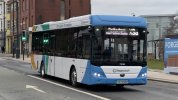Great to hear, in fact an evening working tonight on the X17 between Matlock and Chesterfield was operated using an electric bus. It was running on time so obviously managed the ascent of Slack Hill (1000ft above sea level) without a problem!
I'd be very surprised if it wasn't significantly quicker - last time I was on an MMC up there I decided to see how fast it was going. According to my GPS it dropped to under 20mph. While the power output of the Yutong motor is similar to the ISB in the MMC, the torque output is massively more.
I do wonder how one would cope if they needed to call at the stop part-way up the hill though. That much torque will help them maintain speed up the hill, but starting up hill might not be so easy.
You'd assumed right. Zebra2 funding covers up to 75% of the difference between electric and diesel bus capital cost and 75% of the infrastructure costs. The 25% additional capital costs operators fund so whilst operating costs for electric are cheaper the capital cost remains more so the two tend to balance out over the anticipated vehicle life given the Zebra2 contribution.
Thanks for the details, that's slightly different to what I'd seen elsewhere and does make sense. Are the infrastructure costs only the chargers? While solar in itself won't be much use (as most charging will be overnight) with battery storage it could help bring charging costs down.
The low bridges on the 90 are a challenge, similar to the bridge on the 217 in Kilnhurst. We've challenged manufacturers to come up with a lower height single deck so we can completely electrify the routes at Chesterfield and Rawmarsh depots.
The Enviro100 appears low enough for the 90, but I'd suspect capacity would be a challenge at certain times of day. The 200EV appears to be taller unfortunately. Packaging enough batteries for the range while keeping as much low floor as possible can't be easy.
Was consideration ever given to revising the 90 route to avoid the low bridge? The 25 could be extended to serve Barrow Hill and Staveley, and the 90 and 74 re-routed to help serve Inkersall and Middlecroft more effectively.
Wouldn't Alexander have once been able to produce special low-height bodies for individual operators, back when they were Walter Alexander, the body builder?
I suspect the bigger issue is the need for buses to be low floor. This gives little opportunity to package batteries underneath, so they usually go in the roof. Don't forget also you don't just have the cells, most EV batteries have some sort of cooling system to optimise range and lifetime.
The more 'creative' you get with battery placement, the more expensive the vehicle is to build as well. Plus, if you need to start running wires between cell locations that can affect efficiency. While it's low, wire does have a resistance so you lose some power as heat.
From what I've seen, most low height EVs are either limited range and / or use 'opportunity charging' to allow a smaller battery pack to be used. The costs of doing this for one route at a depot which uses handful of buses usually doesn't make sense, especially as there is a risk that failures may mean not being able to run the route as other vehicles can't be substituted.



